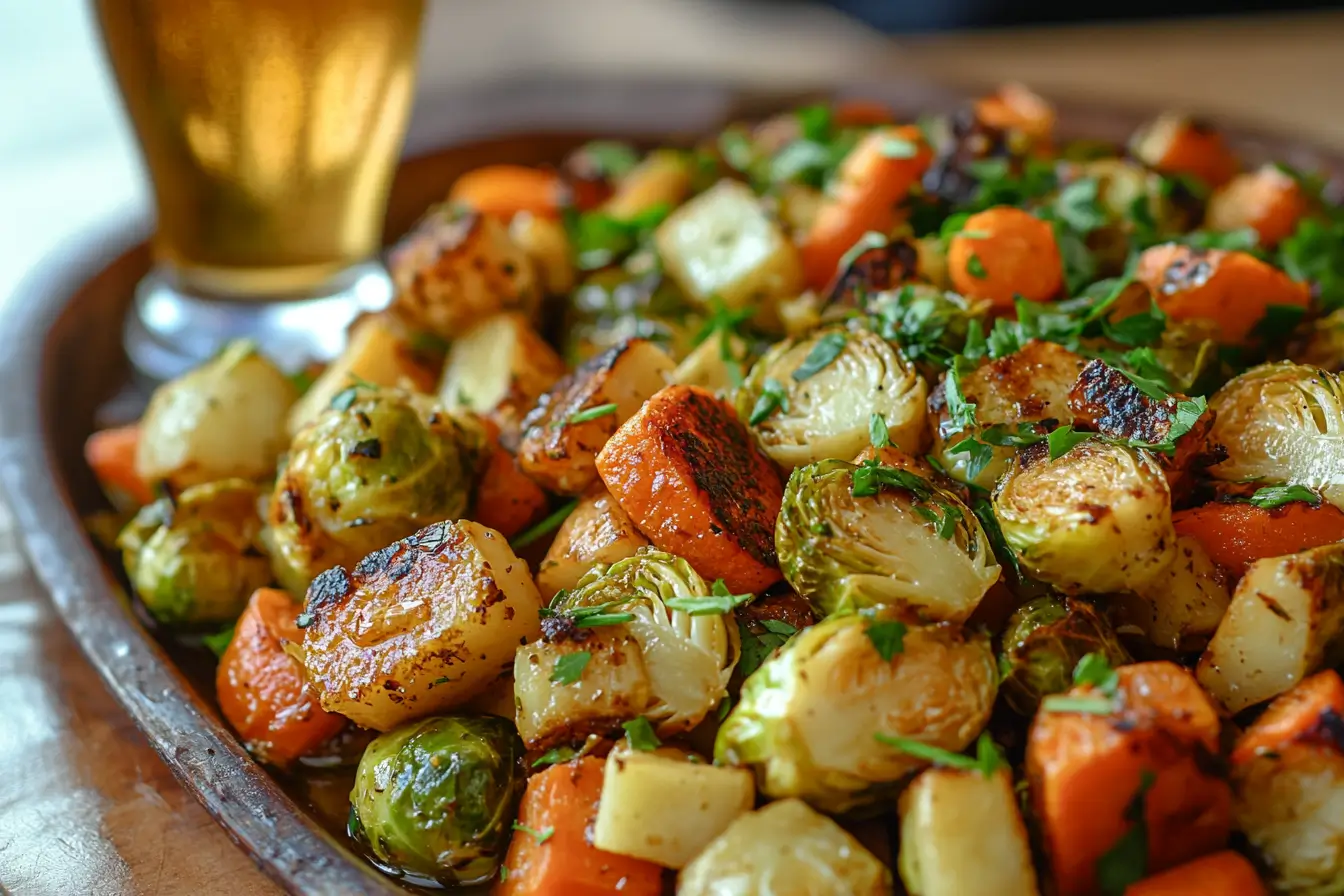Parsnip Nutrition Facts; a versatile and nutrient-rich root vegetable, have been gaining recognition for their impressive health benefits. This comprehensive guide delves into the detailed nutritional profile of parsnips, shedding light on the essential vitamins, minerals, and fiber they contain. From understanding the historical origins of this root vegetable to exploring the modern cultivation and varieties, this article will provide you with a complete overview of parsnips and their role in a healthy diet.
Key Takeaways
- Parsnips are a nutrient-rich root vegetable with a unique flavor profile.
- They are a good source of essential vitamins, minerals, and dietary fiber.
- Incorporating parsnips into a balanced diet can provide various health benefits, such as blood sugar management and heart health support.
- Proper selection and storage methods are important to maximize the nutritional value of parsnips.
- Certain cooking techniques can help preserve the nutritional content of parsnips.
What Are Parsnips? Understanding This Root Vegetable
Parsnips are a fascinating root vegetable with a rich history dating back centuries. These versatile and nutritious roots have been cultivated and enjoyed by cultures around the world, offering a unique flavor profile and a wealth of health benefits.
The Historical Origins of Parsnips
Parsnips are believed to have originated in the regions of Europe and the Mediterranean, where they were initially used as a staple food and medicinal crop. Records indicate that parsnips were consumed by the ancient Greeks and Romans, and they were later introduced to the British Isles, where they became a popular ingredient in traditional British cuisine.
Modern Cultivation and Varieties
Today, parsnips are grown in many parts of the world, with major production centers in North America, Europe, and Asia. Numerous parsnip varieties have been developed, each with its own distinct characteristics. From the slender, tapered roots to the wider, more rounded types, parsnip varieties offer a range of flavors, textures, and culinary applications.
The cultivation of parsnips has evolved over time, with modern farming methods and techniques helping to improve yield, quality, and accessibility of this nutritious root vegetable. Parsnips can be grown in a variety of soil types and climates, making them a versatile crop for both small-scale and large-scale producers.
“Parsnips are a true root vegetable that have stood the test of time, maintaining their popularity and nutritional value throughout history.”
Parsnip Nutrition Facts: Essential Nutrients and Values
Parsnips are a rich source of essential nutrients that contribute to overall health and well-being. Understanding the parsnip nutritional value is key to appreciating the many benefits of this versatile root vegetable.
One medium-sized parsnip (about 156 grams) contains:
- Calories: 100
- Carbohydrates: 24 grams
- Fiber: 6 grams
- Protein: 1 gram
- Fat: 0.3 grams
Parsnips are an excellent source of vitamins and minerals, providing a significant amount of the daily recommended intake. Some of the key nutrients found in parsnips include:
- Vitamin C: One parsnip contains nearly 25% of the daily requirement.
- Folate: Parsnips provide 10% of the recommended daily intake.
- Potassium: A single parsnip contains around 7% of the daily potassium needs.
- Manganese: Parsnips are a good source of this essential mineral, providing 15% of the daily requirement.
The high fiber content in parsnips, around 6 grams per serving, makes them a wonderful addition to a balanced diet. Fiber promotes digestive health, helps regulate blood sugar levels, and supports cardiovascular function.
“Parsnips are a nutritional powerhouse, offering a wide range of essential vitamins, minerals, and fiber to support overall health.”
Incorporating parsnips into your meals is an easy way to boost your intake of these valuable nutrients and enjoy the many health benefits they provide.
The Impressive Health Benefits of Parsnips
Parsnips are not only delicious root vegetables, but they also offer a wide range of impressive health benefits. From regulating blood sugar levels to supporting cardiovascular health and boosting the immune system, this versatile veggie packs a powerful nutritional punch.
Blood Sugar Management
Parsnips are a great choice for individuals looking to manage their blood sugar levels. They are low in carbs and high in fiber, which can help slow the absorption of sugars and prevent spikes in blood glucose. Additionally, parsnips contain compounds like vitamin C and magnesium, which have been linked to improved insulin sensitivity and better overall blood sugar control.
Heart Health Support
Parsnips are rich in potassium, a mineral that plays a crucial role in maintaining healthy blood pressure levels. Furthermore, they contain antioxidants that can help reduce inflammation and protect the cardiovascular system from damage. Studies have shown that regular consumption of parsnips may help lower the risk of heart disease and stroke.
Immune System Boosting Properties
Parsnips are a fantastic source of vitamins and minerals that are essential for a well-functioning immune system. They are particularly high in vitamin C, vitamin E, and folate, all of which play a crucial role in supporting the body’s natural defenses against illness and infection. Incorporating parsnips into your diet can help strengthen your immune system and keep you healthy.
With their impressive array of parsnip health benefits, it’s easy to see why this humble root vegetable should be a staple in any healthy diet. Whether you’re looking to control your blood sugar, support your heart health, or boost your immune system, parsnips are a fantastic addition to your mealtime repertoire.

Parsnips vs. Other Root Vegetables: A Nutritional Comparison
When it comes to root vegetables, parsnips often stand out for their unique nutritional profile. Let’s take a closer look at how parsnips compare to other popular options like potatoes and carrots.
| Nutrient | Parsnips | Potatoes | Carrots |
|---|---|---|---|
| Calories (per 100g) | 75 | 77 | 50 |
| Carbohydrates (per 100g) | 17g | 17g | 10g |
| Fiber (per 100g) | 4.9g | 2.2g | 2.8g |
| Vitamin C (per 100g) | 10mg | 19mg | 5mg |
| Vitamin K (per 100g) | 18μg | 2μg | 13.1μg |
| Folate (per 100g) | 50μg | 12μg | 19μg |
The data reveals that parsnips outshine potatoes and carrots in several key areas. Parsnips boast higher fiber content and are an excellent source of essential vitamins like vitamin K and folate. While potatoes have a slight edge in vitamin C, parsnips provide a more balanced nutritional profile overall.
When it comes to the parsnips vs. potatoes debate, the comparison suggests that parsnips may be the healthier choice, offering more fiber and important vitamins without significantly more calories. And when stacked up against carrots, parsnips prove to be a unique and valuable addition to a well-rounded diet.
Ultimately, incorporating a variety of root vegetables, including parsnips, into your meals can provide a diverse array of essential nutrients and health benefits.
How to Select and Store Parsnips for Maximum Nutrition
Parsnips are a versatile and nutrient-dense root vegetable that can elevate any meal. To ensure you’re getting the most out of these flavorful roots, it’s important to understand the proper techniques for selecting and storing them. Let’s dive into the key tips for choosing fresh parsnips and preserving their valuable nutrients.
Selection Tips for Fresh Parsnips
When shopping for parsnips, look for roots that are firm, smooth, and free of blemishes or discoloration. Selecting fresh parsnips is the first step in ensuring you get the most nutrition. Avoid any parsnips that appear soft, shriveled, or have visible signs of damage.
- Choose parsnips that are uniform in size and shape for even cooking.
- Look for parsnips with a bright, creamy white color.
- Inspect the tops, ensuring they are intact and not wilted.
- Gently squeeze the parsnips to check for firmness – they should have a slight give but not feel soft or spongy.
Proper Storage Methods
Once you’ve selected the perfect parsnips, it’s crucial to store them properly to preserve their nutrients. Proper storage techniques can help extend the shelf life of parsnips and maintain their texture and flavor.
- Trim off the green tops, leaving about an inch of the stem intact.
- Place the parsnips in a perforated plastic bag or wrap them in a damp paper towel.
- Store the parsnips in the refrigerator’s crisper drawer, where they’ll stay fresh for up to two weeks.
- Avoid storing parsnips at room temperature, as this can cause them to soften and lose their crunch.
By following these simple tips for selecting fresh parsnips and storing them properly, you can ensure that your parsnips retain their valuable nutrients and deliver maximum flavor in your cooking.
Cooking Methods That Preserve Parsnip’s Nutritional Value
When it comes to cooking parsnips, the key is to choose preparation techniques that retain the vegetable’s impressive nutritional profile. Parsnips are packed with essential vitamins, minerals, and antioxidants, and the way you cook them can have a significant impact on nutrient retention.
One of the healthiest ways to enjoy parsnips is by roasting them. Oven roasting helps preserve the parsnip’s natural sweetness and enhances their creamy texture. To maximize nutrient retention, simply toss the parsnips with a drizzle of olive oil, season with herbs and spices, and roast at a high temperature until they’re tender and caramelized.
Steaming is another excellent cooking method for parsnips. This gentle technique helps retain the vegetables’ water-soluble vitamins, such as vitamin C and B-complex vitamins. When steaming parsnips, be sure to avoid overcooking them to prevent nutrient loss.
- Roasting parsnips at high heat helps preserve their natural sweetness and nutrients.
- Steaming parsnips is a gentle cooking method that retains water-soluble vitamins.
- Avoid boiling parsnips, as this can lead to significant nutrient loss.
While boiling may be a convenient cooking method, it’s not the best choice for maximizing the nutritional value of parsnips. The prolonged exposure to hot water can cause water-soluble vitamins and minerals to leach out, leaving you with a less nutrient-dense dish.
By choosing cooking techniques that preserve parsnip’s nutritional profile, you can enjoy the full health benefits of this versatile root vegetable. Whether you roast, steam, or incorporate parsnips into your favorite dishes, you’ll be nourishing your body with essential nutrients.

Potential Health Risks and Considerations
While parsnips are generally considered a healthy and nutritious vegetable, there are a few potential health risks and considerations to keep in mind. These include allergies, sensitivities, and interactions with certain medications.
Allergies and Sensitivities
Some individuals may experience parsnip allergies or food sensitivities. Symptoms can range from mild skin irritation to more severe reactions like difficulty breathing or gastrointestinal distress. Those with a history of food sensitivities should be cautious when introducing parsnips into their diet and monitor for any adverse reactions.
Interaction with Medications
Parsnips may also interact with certain medications. For example, the high levels of vitamin K in parsnips can interfere with blood-thinning medications like warfarin. Individuals taking prescription drugs should consult with their healthcare provider before significantly increasing their parsnip consumption.
| Potential Parsnip-Related Health Risks | Symptoms | Precautions |
|---|---|---|
| Parsnip Allergies | Skin irritation, difficulty breathing, gastrointestinal distress | Monitor for adverse reactions when introducing parsnips to the diet |
| Food Sensitivities | Varied, depending on the individual | Consult with a healthcare provider before consuming parsnips |
| Medication Interactions | Interference with blood-thinning medications | Discuss with a healthcare provider before significantly increasing parsnip consumption |
By being aware of these potential health risks and considerations, individuals can enjoy the many benefits of parsnips while taking the necessary precautions to ensure their safety and well-being.
Incorporating Parsnips into a Healthy Diet
Parsnips, often overlooked as a humble root vegetable, are a true nutritional powerhouse that deserve a prominent place in a balanced diet. Beyond their delicious flavor, these versatile veggies offer an impressive array of essential vitamins, minerals, and fiber that can seamlessly integrate into a wide range of healthy recipes.
To maximize the benefits of parsnips, consider incorporating them into your meals in various ways. Roasted parsnip wedges make a satisfying and nutrient-dense side dish, while grated parsnips can add a subtle sweetness and crunchy texture to salads. For a heartier option, parsnip puree or mash pairs beautifully with lean proteins like grilled chicken or roasted salmon.
When it comes to the question, “Are parsnips a superfood?”, the answer is a resounding yes. These root vegetables are packed with essential nutrients that support overall health, including dietary fiber, vitamin C, potassium, and folate. Incorporating parsnips into a balanced diet can contribute to better blood sugar regulation, improved heart health, and a stronger immune system.
To inspire your culinary adventures with parsnips, consider these delightful recipe ideas:
- Roasted Parsnip and Apple Soup
- Parsnip and Carrot Fritters with Lemon Dill Sauce
- Parsnip and Potato Gratin
- Parsnip Fries with Garlic Herb Dip
By embracing the versatility and nutritional benefits of parsnips, you can easily incorporate these superfood status veggies into your balanced diet and elevate your overall health and well-being.
Conclusion
In this comprehensive guide, we’ve explored the remarkable nutritional profile and impressive health benefits of the humble parsnip. From its historical origins to modern cultivation, this versatile root vegetable has earned its place as a nutritional powerhouse worthy of a prominent spot in a healthy diet.
The parsnip nutrition summary revealed an abundance of essential vitamins, minerals, and fiber that can support blood sugar management, heart health, and immune system function. By comparing parsnips to other root vegetables, we’ve highlighted their unique nutritional advantages, making a compelling case for incorporating them into your meals.
The health benefits recap showcased how parsnips can positively impact various aspects of your wellbeing, from regulating blood sugar levels to providing immune-boosting properties. With valuable insights on selecting, storing, and preparing parsnips to preserve their nutrients, this guide empowers you to make informed choices and enjoy the full spectrum of benefits this versatile vegetable has to offer.
FAQ
Do parsnips have any health benefits?
Yes, parsnips are packed with a variety of essential nutrients that offer numerous health benefits. They are rich in dietary fiber, vitamins, and minerals that can support blood sugar management, heart health, and the immune system.
Are parsnips better for you than potatoes?
In many ways, parsnips are a healthier choice compared to potatoes. Parsnips contain fewer calories, more fiber, and a higher concentration of vitamins and minerals. While potatoes can be part of a balanced diet, parsnips provide a more nutrient-dense alternative.
Which is healthier, parsnip or carrot?
Both parsnips and carrots are highly nutritious root vegetables, but they have slightly different nutritional profiles. Parsnips tend to be higher in fiber, potassium, and certain vitamins, while carrots generally contain more beta-carotene and vitamin A. Ultimately, both can be excellent additions to a healthy diet, and the choice often comes down to personal preference.
Are parsnips a superfood?
While the term “superfood” is not officially defined, parsnips can be considered a nutrient-rich food that offers exceptional health benefits. They are packed with essential vitamins, minerals, and antioxidants, making them a valuable addition to a balanced and nutritious diet.

